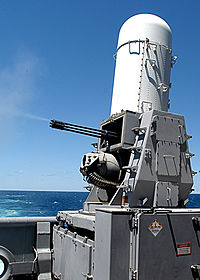User:Sarcastic ShockwaveLover/CIWS

A Close-in weapon system (CIWS) is a naval shipboard point-defense weapon for detecting and destroying incoming anti-ship missiles and enemy aircraft at short range (the threat(s) having penetrated the fleet's available outer defenses). Typically, the acronym is pronounced "sea-whiz".
A CIWS usually consists of a combination of radars, computers, and multiple rapid-fire medium-calibre guns placed on a rotating gun mount. Examples of CIWS products in operation are
- German/Swiss Millennium 35 mm Naval Revolver Gun System [1] [2]
- United States Raytheon Phalanx system
- Dutch Goalkeeper
- Swiss Sea Zenith
- Spanish Meroka CIWS
- Russian AK-630 or Kashtan
- Italian DARDO or Myriad
- Chinese Type 730
- Israeli Typhoon
- South African Denel 35DPG[3]
- Indian DRDO BC-350 Chanakya [citation needed]
Nearly all classes of modern warship are equipped with some kind of CIWS device.
Missile systems
[edit]Some platforms use missile systems instead of guns, because guns have certain limitations:
- Short range: The maximum effective range of 30-mm gun systems is about 4500 m; systems with lighter projectiles have even shorter range. The expected real-world kill-distance of an incoming anti-ship missile is about 500 m or less, [citation needed] still close enough to possibly cause damage on the ship's sensor or communication arrays. Also the timeframe for interception is relatively short; for supersonic missiles moving at 1500 m/s it is approximately one-third of a second.
- Limited kill probability: Even if the missile is hit and damaged, it may not be enough to destroy it or change its course enough, to prevent it or fragments of it from hitting its intended target (short interception distance, see above). This is especially true if the gun fires kinetic-energy-only projectiles).
- Guns can only fire at one target at a time and switching targets may take up to one second for training the gun.
- For a gun hitting a target traveling at high speed, it has to predict its course and aim ahead of it since mid-course corrections of projectiles are not possible. Modern anti-ship missiles make erratic moves before impact, reducing the probability of being hit.
Because of their greater range, a missile-CIWS can also be dual-used as a short-ranged area-defense anti-air weapon, eliminating the need of a second mount for this role.

After an inertial guidance phase CIWS missile relies on infra-red, passive radar/ESM or semi-active radar terminal guidance or a combination of these. The ESM-mode is particularly useful since most long-range anti-ship missiles use radar to home in on their targets. Some systems allow the launch platform to send course-correction commands to the missile in the inertial guidance phase.
Examples include:
- Crotale-NG
- RAM - SeaRAM is a companion to the Phalanx, using Phalanx' sensor suite and an 11-missile RAM launcher
- Sadral, using a version of the Mistral missile
- Sea-Sprint, using the ADATS missile
- Modernized Sea Wolf
- Sea Sparrow Block 1, Missile used by the Nimitz class carriers, and other USN ships, as a short to medium range anti-aircraft weapon.
- Evolved Sea Sparrow missile, used aboard all Sea Sparrow-capable warships, plus other warships of the Netherlands, Canadian, Spanish, Japanese, Turkish and Australian navies.
- SA-N-11 Grisom missile, used by the Russian and Chinese navies as part of the CADS-N-1 system.
- HQ-7 missile, a Chinese missile system, standard for all ships.
- Barak SAM, an Israeli point defence missile system also used by Indian Navy.
